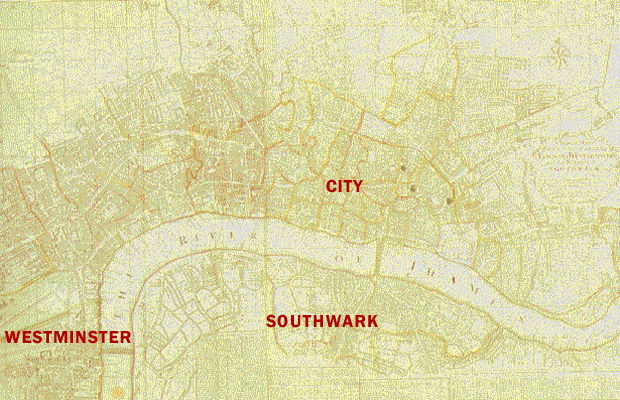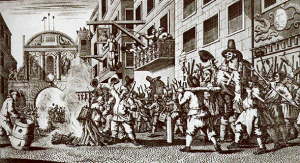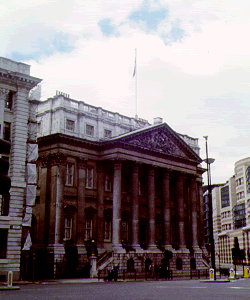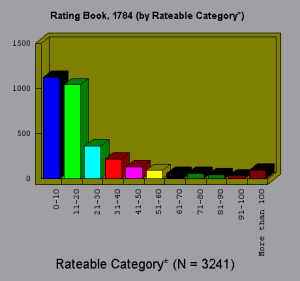The population of London
In the 18th century, the population of the London area increased from half a million to one million inhabitants.
Tax Liabilities of householders1
Tax Liabilities of Male and Female Householders, City of London Poll Tax, 1692: percentage paying additional tax by sex and marital status
| 1s tax only % | 10s additional tax % | £1 additional tax % | Total N (100%) | |
|---|---|---|---|---|
| Males | ||||
| presumed single | 87% | 8% | 5% | 1415 |
| married | 65% | 24% | 12% | 1154 |
| presumed widowed | 35% | 33% | 31% | 48 |
| Females | ||||
| presumed single | 98% | - - | 2% | 1359 |
| presumed widowed | 81% | 5% | 14% | 142 |
The 10 shilling additional tax was payable by tradesmen, shopkeepers and vinters with estates worth £300 or more.
The 20 shilling (£1) additional tax payable by merchants trading overseas; those who ascribed themselves ’gentlemen’ who had estates worth over £300; women with estates over £1,000; the clergy; and a variety of professions.
1Hollaender, A. E. and Kellaway, W. (eds.), Studies in London History Presented ti P.E. Jones, (Hodder and Stoughton, 1969). Table from article by D.V. Glass, ’Socio-economic status and occupations in the City of London at the end of the seventeenth century’
From Tim Hitchcock and Robert Shoemaker, Economic Growth and Social Change in the Eighteenth-Century English Town (TLTP CDRom, Glasgow, 1998)
London Area

- Bowles’s map of London
- Bowles’s map of London (1764)
The tensions between London and Westminster are evoked in Hogarth’s Marriage a la Mode.
The City of London (ruled by Aldermen and the Lord Mayor), Westminster and Southwark were distinct administrative entities.

- Temple Bar
- [click on the picture to enlarge it]
The “bills of mortality” (tables registering the deaths), however, concerned the whole area, and “London” is sometimes taken to refer to the larger region covered by them.
The City was the centre of trading activities, it was inhabited by the merchants. Westminster was the residence of the Court and the political capital (Parliament), as well as the district of aristocratic townhouses in the new urban developments.
The City of London and Westminster were separated by Temple Bar; their symmetry was emphasised when Westminster Bridge was built, in addition to London Bridge in the City.
Lord Mayor

- Mansion House
- [click on the picture to enlarge it]
Mansion House, the residence of the Lord Mayor, built by the architect George Dance in the mid 18th century.
Rating Book of St George Hanover Square

- Rating Book, 1784
- From Tim Hitchcock and Robert Shoemaker, Economic Growth and Social Change in the Eighteenth-Century English Town (TLTP cdrom, Glasgow, 1998)
Table drawn with permission from Charles Harvey, Edmund Green and Penelope Corfield, The Westminster Historical Database (Bristol Academic Press CDRom, Bristol, 1998)
[click on the picture to enlarge it]
A graph and table of the distribution of rateable values showing the distribution of wealth among the population of St George Hanover Square (at least for those who paid rates - about 50%).
Drawn from St George Hanover Square, Westminster. Rating Book for 1784.
It includes the rateable value of each house (the notional rental value=the amount the parish believed each house would cost to rent on an annual basis), and by doing so gives us access to the distribution of value committed by each household to its housing cost.
Hanover Square was one of the new developments for “people of distinction” in the Western part of the metropolis.

